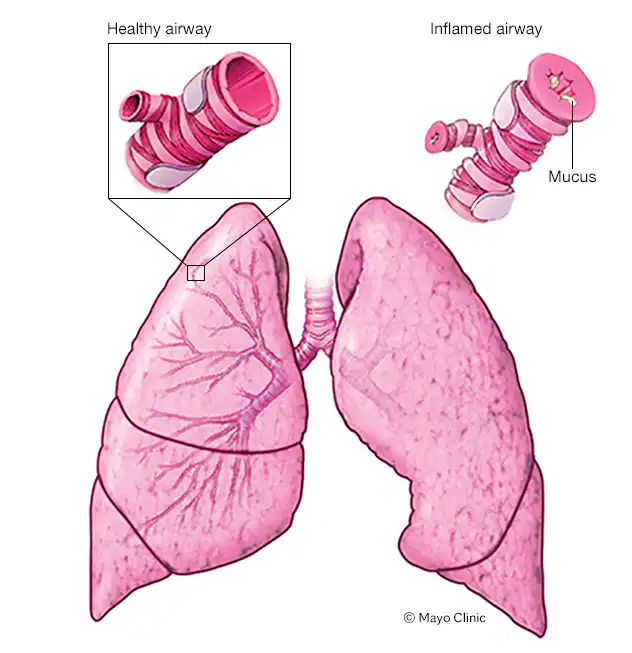Asthma: A Comprehensive Guide . Asthma, also referred to as bronchial asthma, is a chronic respiratory condition that affects the airways in your lungs. Individuals with asthma experience inflammation, swelling, and narrowing of the air passages, which makes breathing difficult. The condition can cause excess mucus production, further obstructing airflow. While asthma cannot be cured, its symptoms can be effectively managed with proper medical care.
Over 25 million people in the United States live with asthma, including more than 5 million children. Without proper treatment, asthma can become a life-threatening illness.asthma a comprehensive guide.
Understanding Asthma Attacks : A Comprehensive Guide
An asthma attack, also known as an exacerbation, occurs when the muscles surrounding the airways tighten, the lining becomes inflamed, and thick mucus blocks airflow. These three events—bronchospasm, inflammation, and mucus buildup—make it difficult for air to pass through the lungs. This can cause wheezing, shortness of breath, chest tightness, and coughing.
Types of Asthma Explained: Your Complete Guide
Asthma is classified based on severity and triggers:
By Frequency and Severity:
-
Intermittent Asthma: Symptoms occur occasionally, with normal breathing between episodes.
-
Persistent Asthma: Symptoms are present more frequently and are classified as mild, moderate, or severe depending on intensity.
By Triggers:
-
Allergic Asthma: Triggered by allergens such as pollen, mold, or pet dander.
-
Non-Allergic Asthma: Brought on by factors like stress, cold air, exercise, or respiratory infections.
By Age of Onset:
-
Adult-Onset Asthma: Begins after the age of 18.
-
Childhood Asthma: Usually diagnosed before the age of 5. Some children may outgrow their symptoms over time.
Other Specific Forms:
-
Exercise-Induced Asthma: Triggered by physical activity.
-
Occupational Asthma: Caused by workplace irritants like chemicals or dust.
-
Asthma-COPD Overlap Syndrome (ACOS): A condition where features of asthma and chronic obstructive pulmonary disease occur together.
Who Is at Risk of Developing Asthma?
Asthma can affect people of all ages, though some groups are at higher risk. Individuals with a family history of asthma or allergies, or those exposed to environmental irritants like smoke, chemicals, or air pollution, are more likely to develop the condition. It is more prevalent in women and disproportionately affects Black communities in the U.S.
Causes and Triggers of Bronchial Asthma
Primary Risk Factors:
-
Genetics: Family history of asthma or allergies.
-
Allergies: Especially to airborne substances.
-
Environmental Exposures: Including secondhand smoke, air pollution, and chemical fumes.
-
Infections: Respiratory viruses can damage developing lungs in children.
Common Asthma Triggers:
-
Air Pollution: Vehicle emissions, industrial smoke, wildfire fumes.
-
Dust Mites: Microscopic bugs found in homes.
-
Physical Exercise
-
Mold: Especially in damp indoor spaces.
-
Pests: Such as cockroaches or rodents.
-
Pets: Dander from animals can irritate airways.
-
Tobacco Smoke: Both firsthand and secondhand exposure.
-
Strong Odors and Chemicals
-
Occupational Hazards: Including flour, wood dust, or cleaning agents.
Signs and Symptoms of Bronchial Asthma
Asthma symptoms vary from person to person and may include:
-
Tightness or pressure in the chest
-
Persistent coughing, especially at night
-
Difficulty breathing or shortness of breath
-
Wheezing—a whistling sound when exhaling
Symptoms may not always be constant and can change in severity and frequency.
ALSO VISIT
Diagnosis of Bronchial Asthma
Diagnosing asthma involves a comprehensive evaluation by a healthcare provider, including:
-
Medical History: Personal and family history of asthma, allergies, or eczema.
-
Spirometry: A test that measures how much and how quickly you can exhale.
-
Additional Tests: Chest X-rays, blood work, or allergy skin tests may also be ordered to rule out other conditions.
Asthma Treatment and Management: A Step-by-Step Guide
Asthma treatment aims to control symptoms and prevent flare-ups. Treatment options include:
Medications:
-
Bronchodilators: Provide quick relief by relaxing airway muscles.
-
Anti-Inflammatory Drugs: Reduce airway inflammation and mucus production.
-
Biologics: Advanced treatment for severe asthma cases unresponsive to standard therapy.
Medications can be administered through inhalers, nebulizers, or orally, depending on the treatment plan.
Asthma Control and Monitoring
The goal is to maintain control over symptoms so individuals can live normal lives with minimal disruptions. This means:
-
Few or no daytime or nighttime symptoms
-
Reduced need for rescue inhalers
-
Ability to engage in normal physical activity
-
Good quality sleep
Monitoring Tools:With Bronchial Asthma
-
Peak Flow Meter: Helps monitor airflow from the lungs and detect early signs of worsening asthma.
Living with Bronchial Asthma: Tips for Daily Life
Your healthcare provider will create a customized action plan that outlines:
-
When to take medications
-
How to monitor symptoms
-
When to seek emergency care
Emergency Care for Severe Attacks Bronchial Asthma
Use a rescue inhaler immediately during an asthma attack. Seek emergency help if you experience:
-
Inability to speak clearly
-
Rapid breathing or chest pain
-
Lips or fingernails turning blue or gray
-
No relief from inhaler use
Outlook and Long-Term Prognosis Bronchial Asthma
While asthma cannot be cured, with proper treatment, individuals can live active, fulfilling lives. Early diagnosis and consistent management are key to preventing complications.
Preventing Asthma Attacks
Although asthma itself cannot be prevented, attacks can often be avoided by identifying and steering clear of triggers. Maintaining a healthy environment and taking medications as prescribed are crucial.
Frequently Asked Questions
Can Asthma Go Away?
Asthma is a lifelong condition, though some children may outgrow it. Adults rarely do.
Why Are Symptoms Worse at Night
Several factors can worsen asthma at night, including:
-
Sleeping posture
-
Allergens in bedding
-
Reflux or mucus drainage
-
Hormonal changes in lung function
-
Uncontrolled daytime symptoms
How Does COVID-19 Affect Bronchial Asthma Patients
People with moderate to severe asthma may face higher risks of severe illness from COVID-19. Vaccination, mask-wearing, and avoiding known exposures are important preventive strategies.
Final Thoughts
Asthma is a manageable condition with the right support and treatment plan. Many people, including top athletes, lead full and successful lives despite having asthma. The key lies in understanding your triggers, using your medications properly, and maintaining regular communication with your healthcare provider.



